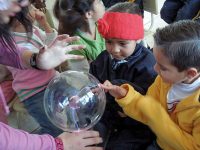
|
Valerie Jane Morris Goodall won the XXVII Premi Internacional Catalunya this year. It is a perfect occasion to summarise a very long story. In 1958, Jane Goodall travelled to Kenya with a clear objective in mind: get immersed in African nature to study and write about its wildlife. There, she met the paleoanthropologist Louis Leakey, a pioneer from a long line of scientists (prehistorians, anthropologists and conservationists) with a passion for tracking the origins of humanity. Of humanity? Of hominity? Why don’t we go back even to primates? In this sense, Leakey’s suggestion to Jane Goodall was: Why don’t you go to Gombe (Tanzania) and study the behaviour of wild chimpanzees? Jane spent three months in the jungle observing these great apes. And one day, she was shocked by what was going on in front of her: an adult chimpanzee had created a stick carefully taking away perpendicular branches and all the leaves. Then, the animal introduced the tool into a termite nest, waited for it to be covered in insects and scooped it into its mouth. Jane Goodall had just witnessed an event that forced her to rethink the very essence of what is human. Louis Leakey’s reaction was recorded in the history of science: «Now we must redefine tool, redefine Man, or accept chimpanzees as humans.» Indeed, there was general consensus in the 1970s around the fact that tools (manufacturing and using them) marked the red line that separates humans from any other animal. Since 1049, the commonly accepted definition was the following one by Kenneth Page Oakley: «The most satisfactory definition of man from the scientific point of view is probably Man the Tool-maker.» Jane Goodall’s work fulminated the scientific truth of the time. Interestingly, one of the most universal scientists in the University of Barcelona, Jordi Sabater Pi, reached the same conclusion independently. The discovery sparked a heated debate, divided in seven points by Jordi Serrallonga: — Use of tools. Some birds do it, but only objects that can be found spontaneously in nature. — Manufacture of tools. Tools are not only used, but also created; that is, they cannot be found spontaneously in nature. — Manufacture of manufacturing tools. This feature reflects a high degree of anticipation and sophistication. — Tool maintenance. They are not used and discarded, but owned and repaired when necessary. — Tool standardisation. The designed is adjusted, not anything goes: different designs are tried and chosen and the most suitable one is fixed. — Selection and transportation of raw material. Specimens do not choose the closest raw material. They search for and use the most suitable ones, a fact that implies exploring, finding, memorising and transporting over long distances. — Culture. All of the above is not instinctive: it is learnt! This means that the same animal species in different areas does not show the same practices and that good solutions become good customs. Is the hand so important? Is it so important to extend it with a tool? Well, it is nothing short of the intermediate step between theory and practice. And it is, at the same time, the necessary condition for the development of the brain. The work of Jane Goodall lies, therefore, at the roots of the knowledge we seek about ourselves. She also contributed to what the German philosopher Georg F. Hegel called Zeitgeist, that is, the «Spirit of Time». The current cultural atmosphere permeates an era thanks, mainly, to rational knowledge; that is, it happens via the dialectics rather than beliefs and traditions. Thus evolved, for instance, moral progress, as well as so many of the conquests of human condition, not yet consolidated in the planet, such as the abolition of slavery, democracy, women liberation, overcoming gender abuse, freedom of speech… A new era starts, the one that will put an end to mistreatment of our planet, nature and diversity. |
«The work of Jane Goodall lies at the roots of the knowledge we seek about ourselves» | |





